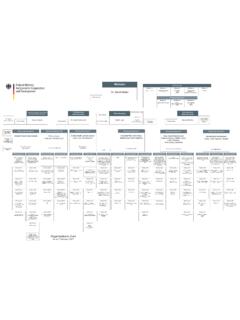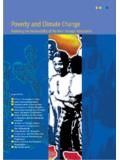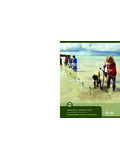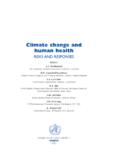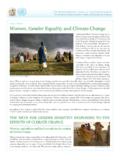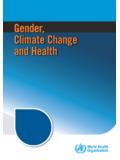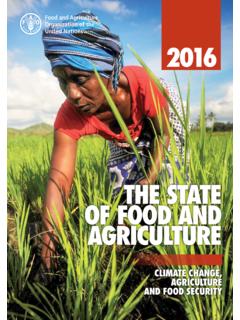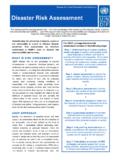Transcription of SOVEREIGN CLIMATE AND DISASTER RISK POOLING
1 SOVEREIGN CLIMATE AND DISASTER RISK POOLINGW orld Bank Technical Contribution to the G20 SOVEREIGN CLIMATE AND DISASTER RISK POOLINGW orld Bank Technical Contribution to the G20 2017 International Bank for Reconstruction and Development / International Development Association or The World Bank1818 H Street NWWashington DC 20433 Telephone: 202-473-1000 Internet: work is a product of the staff of The World Bank with external contributions. The findings, interpretations, and conclusions expressed in this work do not necessarily reflect the views of The World Bank, its Board of Executive Directors, or the governments they World Bank does not guarantee the accuracy ofthe data included in this work.
2 The boundaries, colors, denominations, and other information shown on any map in this work do not imply any judgment on the part of The World Bank concerning the legal status of any territory or the endorsement or acceptance of such and PermissionsThe material in this work is subject to copyright. Because The World Bank encourages dissemination of its knowledge, this work may be reproduced, in whole or in part, for noncommercial purposes as long as full attribution to this work is queries on rights and licenses, including subsidiary rights, should be addressed to the Office of the Publisher, The World Bank, 1818 H Street NW, Washington, DC 20433, USA; fax: 202-522-2422.
3 E-mail: report has been prepared by the World Bank, drawing on inputs from a group of internationally renowned experts comprising David Bresch, Dario Luna, and Simon Young. The World Bank team was led by Olivier Mahul and included Bianca Adam, Benedikt Signer, Simeon Abel, Roberto Dario Bacchini, Richard Poulter, and Emily White, all from the DISASTER Risk Financing and Insurance Program, a joint partnership between the World Bank s Finance and Markets Global Practice and the Global Facility for DISASTER Reduction and team thanks Isaac Anthony, CEO of the Caribbean Catastrophe Risk Insurance Facility (CCRIF SPC)
4 , for sharing information on CCRIF and CCRIF for Central American countries (CCRIF-CA); Mohamed Beavogui, General Director of African Risk Capacity (ARC), and Dolika Banda, CEO of ARC Ltd., for sharing information on ARC; Salvador Perez Maldonado, Associate Director General of Insurance, Ministry of Finance and Public Credit, Mexico, for sharing information on Mexico s Natural DISASTER Fund (FONDEN). The team also thanks participants in the stakeholder consultation meetings held in Berlin on February 9 and March 21, 2017.
5 Internal reviews and inputs from Luis Alton, Michael Bennett, Martin Buehler, Samantha Cook, Julie Dana, Francis Ghesquiere, Eugene Gurenko, Stephane Hallegatte, Hideaki Hamada, Niels Holms-Nielsen, Nicholas Jones, and John Pollner greatly enhanced the report. The report was edited by Anne Himmelfarb. Design and layout were by Studio report was prepared during the period October 2016 April 2017 and was sponsored by the Federal Ministry for Cooperation and Development of Germany (BMZ).
6 SOVEREIGN CATASTROPHE RISK POOLSABBREVIATIONSACP-EU African, Caribbean, Pacific European UnionAPEC Asia-Pacific Economic CooperationARC African Risk CapacityARC Ltd. African Risk Capacity Insurance Company LimitedARV Africa RiskViewASEAN Association of South East Asia Nations BMZ Federal Ministry for Economic Cooperation and DevelopmentCARICOM Caribbean CommunityCAT bond catastrophe bondCAT-DDO Catastrophe Deferred Draw-Down OptionCCRIF Caribbean Catastrophe Risk Insurance Facility (CCRIF SPC since 2014)CCRIF-CA Caribbean Catastrophe Risk Insurance Facility for Central American countriesCOSEFIN Council of Finance Ministers of Central American countries plus the Dominican Republic and PanamaDFID United Kingdom Department for International DevelopmentDPF Development Policy FinancingEAP East Asia and Pacific ECA Economics of CLIMATE AdaptationFONDEN Natural DISASTER Fund (Fondo de Desastres Naturales)
7 GDP gross domestic productGFDRR Global Facility for DISASTER Reduction and Recovery HSNP Hunger Safety Net ProgrammeIBRD International Bank for Reconstruction and Development IDA International Development Association IMF International Monetary FundIRMS Integral Risk Management Strategy L4D Licensing for Development programMDB multilateral development bankNPV net present value OECS Organization of Eastern Caribbean StatesPCRAFI Pacific Catastrophe Risk Assessment and Financing Initiative PEF Pandemic Emergency Financing Facility PSNP Productive Safety Net ProgrammeSDG Sustainable Development GoalSPC Secretariat of the Pacific Community TCIP Turkish Catastrophe Insurance PoolV20 Vulnerable Twenty GroupSOVEREIGN CATASTROPHE RISK POOLS1 TABLE OF CONTENTSO verview 3 Introduction 8 PART 1.
8 Managing the financial impact of CLIMATE and DISASTER risks 10 The drivers of DISASTER impacts: A look into the future 11 The many impacts of disasters: From public finances to poverty reduction 14 Fiscal and economic impact 14 Development and poverty impacts 14 The elements of an effective approach to DISASTER preparedness and crisis response 16 Coordinated plan for post- DISASTER action agreed in advance 16 Fast, evidence-based decision-making process 17 Pre-planned financing to ensure that the plan can be implemented 17 Growing interest 18 Going beyond CLIMATE and DISASTER risks .
9 A comprehensive approach to risk management and crisis response 19 Financial protection: From post- DISASTER emergency borrowing to proactive risk management 20 Selecting the appropriate financial protection instruments 24 Insurance: A powerful tool to be used with caution 28 PART 2. Lessons learned from experiences of SOVEREIGN catastrophe risk pools 30 Global landscape of SOVEREIGN catastrophe risk pools for developing countries 33 Existing SOVEREIGN catastrophe risk pools 33 New initiatives for SOVEREIGN catastrophe risk pools 39 Efficiency of catastrophe risk pools 40 Political ownership 41 Financial efficiency 43 Operational efficiency 48 Sustainability of catastrophe risk pools 50 Who owns the risk?
10 50 Technical expertise 50 Risk-based pricing 51 Premium financing 51 Regional ownership 56 Increasing the impact of SOVEREIGN catastrophe risk pools 57 Public financial management of natural disasters 57 Shock-responsive social protection 58 Critical infrastructure 59 Crowding in the private sector 59 PART 3. Recommendations moving forward 60 Catastrophe risk pools can enhance the financing of CLIMATE and DISASTER risks 61 Catastrophe risk pools do not solve all CLIMATE and DISASTER risk financing problems 63 Recommendations for G20 members 64 SOVEREIGN CATASTROPHE RISK POOLS2 Glossary 66 Annex 1.



